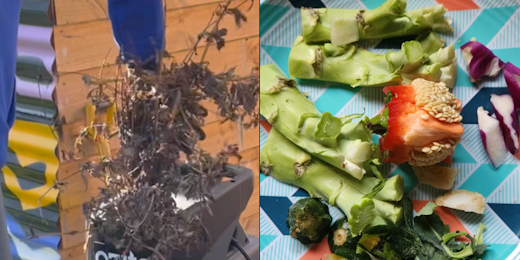
Types of compostable waste and how to handle them
We make compost from our organic waste by accelerating a natural microbial process. What's important is having a moist environment with plenty of air for compost microbes to thrive.
Part of the secret is knowing which compost system is better for wastes that come mainly from the garden or from the kitchen.
Garden waste
Compostable wastes are usually sorted as either carbon or nitrogen types. Gardens generate both types in varying amounts all year. Twigs and shrub trimmings are examples of carbon types which can be gathered, cut up or shredded, and stored till you have enough to make a batch of compost. Their stiffness also lets them provide structure - they create internal passages for air to flow through.
Nitrogen types from gardens include fresh weeds (without seeds) and grass clippings. They go limp easily and mat to cause problems by stopping airflow when piled up. This matting problem can be solved with stiff or structural carbon waste.
Layering carbon and nitrogen wastes on top of each other is a recipe that originates with the traditional compost heap, but also works for standard bin-type systems like open-ended bins and tumbling bins. Of course, following the systems' instructions is necessary to keep the waste well mixed and suitably moist.
Kitchen waste
Unlike garden waste which become dry when left in a pile, kitchen scraps can quickly start to smell and ooze horrid liquid. Burying the scraps in the ground or landfill can keep away pests like flies and rats, but this produces emissions harmful to the environment. A rewarding alternative is using the right compost system to safely break them down and return the plentiful goodness in scraps as soil richness to the garden.
Kitchen wastes demand more from a bin-type compost system than garden wastes and causes problems for several reasons:
- kitchen waste breaks down faster with an increased demand for oxygen. It starts to smell when oxygen levels fall due to inadequate manual mixing of the waste in bin systems.
- an abnormal over-production of acids can occur with unrestricted input of kitchen scraps. How can you tell? When you get annoyed by an infestation of tiny compost flies.
- kitchen scraps are wet waste which can release water and if in excess, you'll end up with unwanted soggy materials or worse, waterlogged conditions.
The good news is everyday waste from your kitchen can be handled conveniently with Bioverter. It is scientifically designed as a novel continuous system, to unlock then gather all nutrition. Its bespoke design eliminates the need to mix the waste, so simply add your wastes and harvest two useful outputs.
Companion systems for best outcome
Bioverter overcomes the many problems encountered when kitchen scraps are added to standard bin-type compost systems.
It's able to work in harmony with existing compost systems, to handle waste they're not capable of. You'll get better outcome from garden waste through standard bin systems and from kitchen scraps through Bioverter.